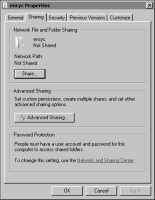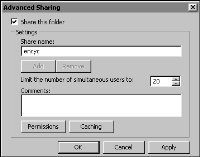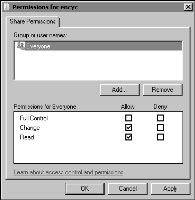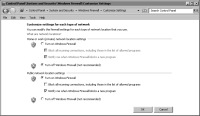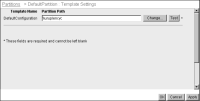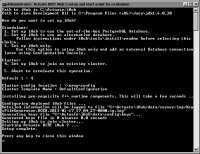Setting up iHub to join an existing cluster
This section assumes the administrator has already created a stand‑alone iHub instance on one computer, as described in
“How to set up iHub to use the out‑of‑the‑box (OOTB) PostgreSQL database,” earlier in this chapter. The stand‑alone iHub instance is the machine that contains the shared configuration home directory, which all nodes in the cluster access. This section refers to the machine containing the shared configuration home directory as node1. In
“How to set up iHub to join an existing cluster,” later in this chapter, the Administrator installs a cluster node. The cluster node accesses the shared resources on node1. This section refers to the machine on which the administrator installs a cluster node as node2.
Before performing a cluster node installation, the administrator performs the following tasks:

On node1:

Turns off the private-network firewall

Obtains the machine host name and IP address

Tests the network accessibility of the machine

Sets the partition path for DefaultPartition in Configuration Console

Configures folder sharing and firewall settings in the network environment

On node2:

Turns off the private-network firewall

Obtains the machine host name and IP address

Tests the network accessibility of the machine
The following instructions provide a basic example of the operations required to configure network sharing and firewall settings in the Windows environment. It is the responsibility of the administrator performing the installation to make sure that all settings conform to the security policies in force for the environment.
How to share the encyc and config folders
Cluster nodes must have read-write access to AC_DATA_HOME\config and AC_DATA_HOME\encyc on node1. To give a cluster node read-write access to the folders and files in the \encyc folder and to the files in the \config folder, perform the following tasks on node1:
1 Using Windows Explorer on node1, right‑click the folder, AC_DATA_HOME\encyc. Choose Properties. On encyc Properties, choose Sharing. Sharing appears as shown in
Figure 6‑43.
Figure 6‑43 Sharing the Encyclopedia volume
On encyc Properties, choose Advanced Sharing.
2 On Advanced Sharing, select Share this folder, as shown in
Figure 6‑44.
Figure 6‑44 Selecting Share this folder
On Advanced Sharing, choose Permissions.
3 On Permissions for encyc—Share Permissions, select the user who installed BIRT iHub. Select Change and Read to allow this user these permissions, as shown in
Figure 6‑45. Make sure that all settings conform to the security policies in force for the environment.
Figure 6‑45 Selecting Change and Read permission
Choose OK.
On Advanced Sharing, choose OK.
On encyc Properties, choose Close.
4 Repeat steps 1 through 3 for the \config folder. Make sure that all settings conform to the security policies in force for the environment.
Close Windows Explorer.
How to turn off the Windows firewall
Perform the following steps on node1 and node2:
1 Choose Start➛Control Panel➛System and Security➛Windows Firewall.
2 On Windows Firewall, choose Turn Windows Firewall on or off. Make sure that all settings conform to the security policies in force for the environment.
3 For example, on Customize Settings, in Home or work (private) network location settings, choose Turn off Windows Firewall, as shown in
Figure 6‑46.
Choose OK.
Figure 6‑46 Turning off the home or work network location firewall
Close Windows Firewall.
How to display a computer’s IP address
To obtain the host names of node1 and the computer on which you will install the cluster node, perform the following tasks on node1 and node2:
1 Choose Start➛Programs➛Accessories➛Command Prompt.
2 In Command Prompt, type the following command:
ipconfig /all
Press Enter. The host name appears, as shown in
Figure 6‑47. In this example, the host name for node1 is urup.
Figure 6‑47 Displaying the host name
3 Write down the host names and IP addresses of the computers to be clustered, as shown in
Table 6‑1.
Table 6‑1 Host names and IP addresses of computers to be clustered
iHub | Host name | IP address |
Node1 | urup | 192.168.30.246 |
Node2 | kozu | 192.168.30.233 |
How to test the connection between computers
Perform the following steps on both computers:
1 In Command Prompt, type the ping command followed by the IP address or host name of the other computer. For example, type the following command to ping a computer named kozu:
ping kozu
Press Enter. If your computer reaches the other computer, Command Prompt displays a series of replies, as shown in
Figure 6‑48.
Figure 6‑48 Receiving a reply to a ping command
2 Close Command Prompt.
How to prepare node1 for clustering
On node1, or urup in this example, perform the following tasks:
1 Log in to Configuration Console by opening a browser and entering the following URL, as shown in
Figure 6‑49. The administrator does not have a password yet, so leave Password blank.
http://localhost:8900/acadmin/config/
Figure 6‑49 Logging in to Configuration Console
2 On the simple view, choose Advanced view. From the side menu, choose Volumes. On Volumes, point to the icon next to the default volume, urup in this example, and choose Take offline, as shown in
Figure 6‑50.
Figure 6‑50 Taking a volume offline
In Volume Offline Grace Period, choose OK.
From the side menu, choose Partitions.
3 On Partitions, point to the icon next to DefaultPartition and choose Template settings, as shown in
Figure 6‑51.
Figure 6‑51 Choosing Template settings
On Template Settings, choose Change. In Partition Path, type the path to the encyc folder, using UNC format. For example, if the hostname of node1 is urup, type:
\\urup\encyc
Figure 6‑52 Typing the partition path
To verify that iHub can access the encyc folder, choose Test.
A message appears, stating that the test was successful, as shown in
Figure 6‑53. Choose OK.
Figure 6‑53 Verifying a successful partition path test
On Template Settings, choose OK.
4 Log out of Configuration Console.
The following section describes how to install and configure the iHub deployment bundle to join an existing cluster.
How to set up iHub to join an existing cluster
After extracting the contents of ActuateBIRTiHub.zip and running the setup script as described in
“How to extract the contents of the iHub distribution package” and
“How to run the setup script,” earlier in this chapter, perform the following tasks:
1 In the setupiHub menu, choose option 4, Set up iHub to join an existing cluster.
2 At the Cluster config location prompt, specify the configuration home location using Universal Naming Convention (UNC) Format, as shown in
Figure 6‑54. For example, type:
\\urup\config
Press Enter.
In an iHub cluster, the configuration home location, AC_CONFIG_HOME, is the shared directory that contains the acserverconfig.xml, acserverlicense.xml, and other related files. In an iHub installation, by default, these files are in AC_DATA_HOME\config. If the shared folder is in this location on a server named urup, then the administrator specifies \\urup\config as the path.
For Cluster Template Name, specify a server template name from the available server templates listed in the shared acserverconfig.xml file, as shown in
Figure 6‑54. For example, type:
DefaultConfiguration
The default template name in the shared acserverconfig.xml in a cloud-based stand‑alone iHub install is DefaultConfiguration.
Press Enter.
Figure 6‑54 Specifying the cluster option, configuration home location, and server template name
The script performs the following tasks, as shown in
Figure 6‑55:

Installs the prerequisite C++ run‑time components

Sets up the iHub deployment files, including log and security keys files

Installs and starts the OOTB PostgreSQL database system used to store Encyclopedia volume metadata

Sets up and starts BIRT iHub 2
Figure 6‑55 Completing the iHub cluster node setup
When the script starts iHub, a new command prompt opens to serve as the Actuate BIRT iHub console from which iHub can be shut down, as shown in
Figure 6‑56.
Figure 6‑56 Viewing Actuate BIRT iHub 2 console
When the script finishes running, press any key to close the command prompt running the setupiHub.bat script, as shown in
Figure 6‑55. If the script exit returns to the command line, type exit to close the command prompt. Be careful to not close the command prompt running the Actuate BIRT iHub console by mistake.
In Windows, the deployment program installs shortcuts to the folder where you extracted the BIRT iHub deployment package. These shortcuts provide access to the following iHub consoles:

BIRT iHub 2 Information Console
Launches Information Console for viewing report documents

BIRT iHub 2 Management Console
Launches Management Console for setting up user accounts and scheduling or running a design
After the script finishes running, a browser opens displaying Welcome to Actuate BIRT iHub, as shown earlier in
Figure 6‑7. Log in to Information Console to perform tasks such as accessing folders and viewing designs and documents.
3 Log in to Configuration Console. On the simple view, scroll down to Account Settings. In New system password, type a new password. In Confirm system password, type the new password again. Then, choose Change password, as shown in
Figure 6‑57.
Figure 6‑57 Creating a new Configuration Console password
4 Scroll to the top of the simple view and choose Advanced view. In the advanced view, choose Servers. In the example, the node named KOZU has joined the cluster, as shown in
Figure 6‑58.
Figure 6‑58 Viewing a cluster composed of two nodes
